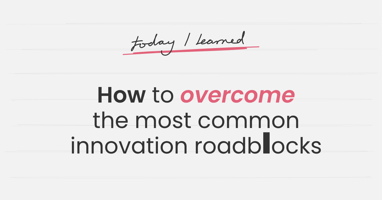Reading time: 4 minutes
Once you’ve identified a great idea that solves a real problem, you need to have a plan that brings it to life. Anyone can have a light bulb moment, but you don’t have a product without a repeatable technique that matches strategy to execution.
I’ve had the privilege of working with brilliant innovators throughout my career — people who’ve found the most direct path from idea to market disruption. Although every product innovation course has unique twists and turns, the most innovative people have a knack for looking at widely accepted beliefs and barriers and asking, “Well, what if?”
Although innovation doesn’t occur in a fantastical dream world where everything is possible, it does require applying a critical eye to certain preconceived notions and finding new ways to move forward. Here are five of the most common product innovation misconceptions that can obstruct innovation and why you should ignore them.
Misconception 1: New product development prototypes are cost-prohibitive
Years ago, I oversaw a university accelerator program. One student presented a new product idea that would allow you to change the design of your sneakers, essentially giving you multiple pairs of shoes for the price of one. He presented a pair of sneakers in his pitch and then put them underneath his desk. A moment later, he pulled out the same pair with a simple cardboard cutout with a new design atop the shoes.
This student crystallized the power of a well-thought-out minimum viable product. He showed us just enough features to frame his vision and get people interested. In today’s tech-forward world, companies can use cost-friendly approaches — like 3-D printing, for example — to build out awe-inspiring minimum viable products. The key is centering the solution to the problem you’re trying to solve and building out. A prototype doesn’t have to be shiny, but it does have to simply and clearly demonstrate how it will solve a problem.
Misconception 2: Innovation is centered on great ideas
Cool for the sake of cool isn’t a sustainable business model. Don’t get me wrong — you have to have brilliant ideas to create innovative products, but millions of revolutionary ideas reside in history’s dustbin. Why? Because they didn’t really solve a problem. Your customer’s pain points and repeated frictions must be your new product development North Star. That’s where your innovation value proposition lies.
And once you’ve identified a great idea that solves a real problem, you need to have a plan that brings it to life. Anyone can have a light bulb moment, but you don’t have a product without a repeatable technique that matches strategy to execution. Look at the companies that continuously bring cool products to the market year after year, decade after decade. Each one has strategies in place that clearly outline tasks and expectations for every step of a product’s timeline.
They adjust those plans as needed, but the process is methodical and effective. When a new idea is approved, all stakeholders understand their roles and responsibilities. Although this isn’t a flashy aspect of new product development, it’s essential to repeat innovation instead of being a one-hit-wonder.
Misconception 3: Innovation will define a company’s culture
In my experience, the opposite is true. You need to have a clear definition of the company’s mission to determine the kinds of innovation you want to develop. Think about Procter and Gamble. Its “Get to know P&G” page states, “We believe in finding small but meaningful ways to improve lives — now and for generations to come.” Nothing about laundry detergent, razors, or shampoo — but those products solve problems that ladder up to that statement. Before a company develops its first widget, it has to clearly define why it’s developing it. If it doesn’t ladder up to its stated purpose as a company, they shouldn’t move forward with that product.
It’s also important to remember that your mission and vision can evolve over time, so some staple products may need to be phased out to keep in a new direction. If you have a history of always innovating based on your mission, this kind of change can be easier. Because, again, your innovation is tied to a larger idea, as opposed to products.
Misconception 4: Innovation methods and processes are fads
Some companies are hesitant to buy into a single innovation method because the hot process of today is out tomorrow. There’s some truth to that. Technology, in general, has shrunken the shelf life of many innovations. However, whether it’s Agile, Lean, Phase Gate or whatever’s next, it’s important to remember that there’s no silver bullet.
The fact is, each business is different, their missions vary, and the customers they serve are diverse. So, it’s more important to adopt the method that makes the most sense to you. Further, you can probably pull helpful ideas from any methodology and adapt them to fit the uniqueness of your organization.
Misconception 5: All research is good research
As they should, companies invest heavily in research. It’s critical to help determine where future efforts should be focused. Unfortunately, many companies find that their investment doesn’t yield results that they can commercialize. Research needs to focus on the company’s mission and includes guardrails that allow the company to apply analysis critical to product development. It should help them solve customer problems, which, in turn, can fuel growth.
Over time, commonly held beliefs are just assumed to be accurate, even if they don’t hold as much water as they used to. Question them. See if they still apply. Most importantly, don’t let them be a barrier to innovation.
To learn more about product innovation, watch this webinar 'Make Every Product Launch a Success: A Conversation with Welch’s VP of Innovation'.
This article originally appeared in Forbes







